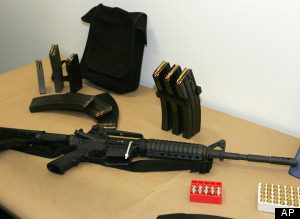
One of the guns used in Newton – A Bushmaster. Not a gun for hunting anything but humans
Children Die Every Day from Guns

One of the guns used in Newton – A Bushmaster. Not a gun for hunting anything but humans
Children Die Every Day from Guns
I no longer do trauma surgery, as much as I loved it there was one thing that just broke my heart- seeing children die because of guns. The tragedy in Newton is on all of our minds- senseless death of 20 children. Sadly, what was in Newton is the tip of the iceberg.
5740 gun deaths for children in the US 2008 and 2009
The Center for Disease Control reports that the number of firearm deaths of kids younger than 15 is almost 12 times higher in the United States than in the next 25 industrialized countries combined. We average more than 4,000 dead children annually. This would be the same as over 2 Newton events per week. Sixty nine percent died from homicide, and 25% from suicide, the rest were accidental or not determined.
In 2008 there were 88 preschoolers who died and in 2009 there were 85 who died from guns. In addition to the deaths, in those two years over 34,000 children were injured by guns.
I grew up in Ketchikan, Alaska. Lots of hunters there, lots of guns around. When my brother was a teenager he was accidentally shot in the leg by a neighbor- suffering severe neurologic damage to his leg requiring two complex operations. Two kids from our town of 5000 died in hunting accidents. One of my childhood friends committed suicide with his father’s shotgun. I use to think it was an aberration growing up in a small community that had a lot of guns- it turns out that it isn’t that at all. When I started seeing children come into the hospital ER’s – most of them dead on arrival, but every paramedic and doctor trying hard to save them. Try to imagine a 5 year old boy, with a large gunshot wound on his chest, dead, as the paramedics are doing CPR hoping we can save him. I recall another child who we opened up his chest to find his heart in a hundred pieces- a victim of a shotgun.
This happens every day, in every major emergency room. I couldn’t take it, after several years left trauma surgery because kids shouldn’t have to die. Newton brought home again what is going on in epidemic proportions in the United States — more so than any other country.
You can argue all you want about firearms- but kids are never their intended target.
A few disturbing facts:
Many have heard about the tragic death when a child who “finds ” a parent’s gun and plays with it. Turns out that when children of gun-owners were interviewed 39% of them knew where the gun was hidden, in spite of their parents thinking they had hidden it from them. 22% of the children reported playing with the guns, although the parents thought otherwise. Children under the age of 10 were just as likely as older children to know where the guns were “hidden.” Gun safety classes were no guarantee against this- I remember taking this class as a kid in Ketchikan – those children, it was reported, play with the guns as often as those who don’t take the classes.
Correlation is not Causation – the arguments that gun lobby mixes up
I have a great deal of respect for my friends who are hunters, who own guns, who lock them up. I appreciate hunting a great deal- and love the fresh meat. I can understand their love of the guns – they are precision instruments, they are well built – and you can learn to shoot well with them. I don’t want them to loose their sport, or their collection. But lets separate them from those who would use a semi-automatic rifle.
Somewhere, between responsible ownership, there comes this fear that restricting a gun would lead to problems. So, I’ve listened to the arguments of the most rabid pro-gun people, and here is what some of them miss:
There are two types of violence – and for the sake of debate, they need to be separated:
Criminal v Non-criminal behavior
There is violence from criminals and there is violence from non-criminals.
Criminals: they will perform crimes whether they have guns or not. The more guns we can take away from them, the better our society will be. They won’t turn them in, but with expanded laws to put them in jail longer, they think twice. It is easy for criminals to get guns in this society, and yet, there is no evidence that non-criminals having guns stop criminals from their actions. In fact, as a trauma surgeon when I saw gunshot wounds from violent criminals it came in two types: gang violence where sometimes innocent people were shot, but most of them were not innocent, but the worst was when a home invasion took place and the gun owner was shot with their own weapon by the criminal.
Chicago is a prime example of criminal behavior. The gang violence escalated over the year, after the hand-gun ban went into effect. People who like to misapply statistics show that there are more gun deaths since the handgun regulations went into effect than before. Correlation does not equal causation- and this is a prime example. Gun violence has decreased in the last few months, not because more people own guns- but because of more police enforcement.
Crime has gone down as the rate of people in prisons has gone up. There are many statistics showing decrease in crime with the ability of people to have more handguns – but this is correlation not causation. The most common states examined are Michigan, Texas, and Florida- all of which enacted “right-to-carry” law, but all showed lowering trends of murder in the mid 1990′s. If you imprison bad people, crime will go down. If everyone carries a weapon does crime go down? Check out Iraq and Afghanistan. Both have rights to carry, and both have high crime as well as murder rates. Still, the drop in national crime is also seen in Los Angeles, where there is a very restrictive gun law. When you ask criminologists why there is a decrease in violent crime, they note that the spikes happened primarily because of the crack wars, and that the demographic changes, longer criminal sentencing, and better policing techniques are more the answer.
Criminal behavior does not decrease because of handguns, criminal behavior decreases with increased law enforcement. Having an “armed” citizenry does not decrease crime, more law enforcement does. Vigilantes are not welcome in our society.
The idea that gun owners prevent crime is real. But the question is: would you want people in the theater in Aurora to be shooting? Do you want a society with more guns, or less guns?
Non Criminal Behavior:
Colombine, Aurora, Newton, Norway – all acts of violence. All from individuals who are not criminals, but mentally ill. Norway has strict laws and regulations, and points out that while we cannot eliminate all guns, or bad behavior, we can decrease it. All of Europe had less handgun murders than the United States. Just to be clear, of the 25 worst mass shootings in the last 50 years, 16 of them have taken place in the United States. In second place is Finland – which had two mass shootings.
The guns in Newton were legally obtained. Had the Brady bill been continued past its expiration in 2004 those guns would not have been available. The guns obtained to shoot US Representative Giffords, kill the US judge, and several civilians, was legally obtained.
Sadly the Brady bill, which expired, had too many loopholes. In 1996 Australia imposed a strict version of the assault weapons band after a mass shooting. It was followed by the country purchasing back from citizens semi-automatic rifles, pistols, and shotguns.
Suicide rates in Israel went down on weekends when soldiers were directed to leave firearms at the base instead of taking them home. Speaking of Israel, while some state that both Israel and Switzerland have many guns and lax laws, this is incorrect. Both countries have very strict regulations regarding guns.
Armed citizens:
It worries me when people say that they are concerned that if they don’t have guns the government would take over. For this I bring two countries which lost oppressive regiems and are in the process of taking their country back: Egypt and Myanmar. Non-violence. When you look at revolutions that took place with guns- you have Syria, Libia – all with many deaths.
Among the popular press is the story of a young man who stopped a shooting in Pearl River, MS – sadly, this is hyperbole, and not reality. The shooting was not stopped by a 16 year old with a gun – it was stopped when the shooter left.
Conclusion:
I don’t like seeing children die – I have a two year old of my own now, and this hits me harder than it did years ago. No one wants that. We need to get together- all of us, to stop our kids from having more deaths per year than we lose from police officers on the street (and that is just pre-schoolers).
So here is the deal: you can be pro-gun but you can be pro-gun and pro-kid. Be that – please.
How do we prevent gun violence from non-criminals? Do we need assault weapons- or semi-automatic weapons? Do we need longer waiting periods? Both sides need to come together for some common sense regulation here: both in terms of what guns are reasonable, and what guns are not. How we can better protect our society without having to resort to “more guns,” or a “lockdown” of schools. We want a safer society- and safer in the world experience is a society with less guns.
REFERENCES:
The paper below shows that there is a greater risk of firearm homicide where there are more guns
Hepburn, Lisa; Hemenway, David. Firearm availability and homicide: A review of the literature. Aggression and Violent Behavior: A Review Journal. 2004; 9:417-40.
When looking internationally the relationship between homicide and gun availability from 26 countries shows a positive correlation
Hemenway, David; Miller, Matthew. Firearm availability and homicide rates across 26 high income countries. Journal of Trauma. 2000; 49:985-88.
In states that have a lot of guns there is a higher rate of homicide, especially that which includes firearms
Miller, Matthew; Azrael, Deborah; Hemenway, David. Household firearm ownership levels and homicide rates across U.S. regions and states, 1988-1997. American Journal of Public Health. 2002: 92:1988-1993.
When examining gun availability and homicide- and removing a number of counfounding factors – the more guns the more issues:
Miller, Matthew; Azrael, Deborah; Hemenway, David. State-level homicide victimization rates in the U.S. in relation to survey measures of household firearm ownership, 2001-2003. Social Science and Medicine. 2007; 64:656-64.
A look at fire-arm deaths in many countries with many backgrounds and clearly the US was in the lead with homicide and suicides
EG Krug, KE Powell and LL Dahlberg Firearm-related deaths in the United States and 35 other high- and upper-middle income countries. INternational Epidem. Assoc 1998.
Frances Baxley and Matthew Miller. 2006. “Parental Misconceptions about Children and Firearms.” Archives of Pediatrics and Adolescent Medicine, 160(5): 542-547. http://archpedi.ama-assn.org/cgi/reprint/160/5/542.








